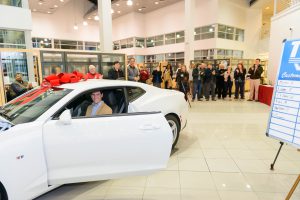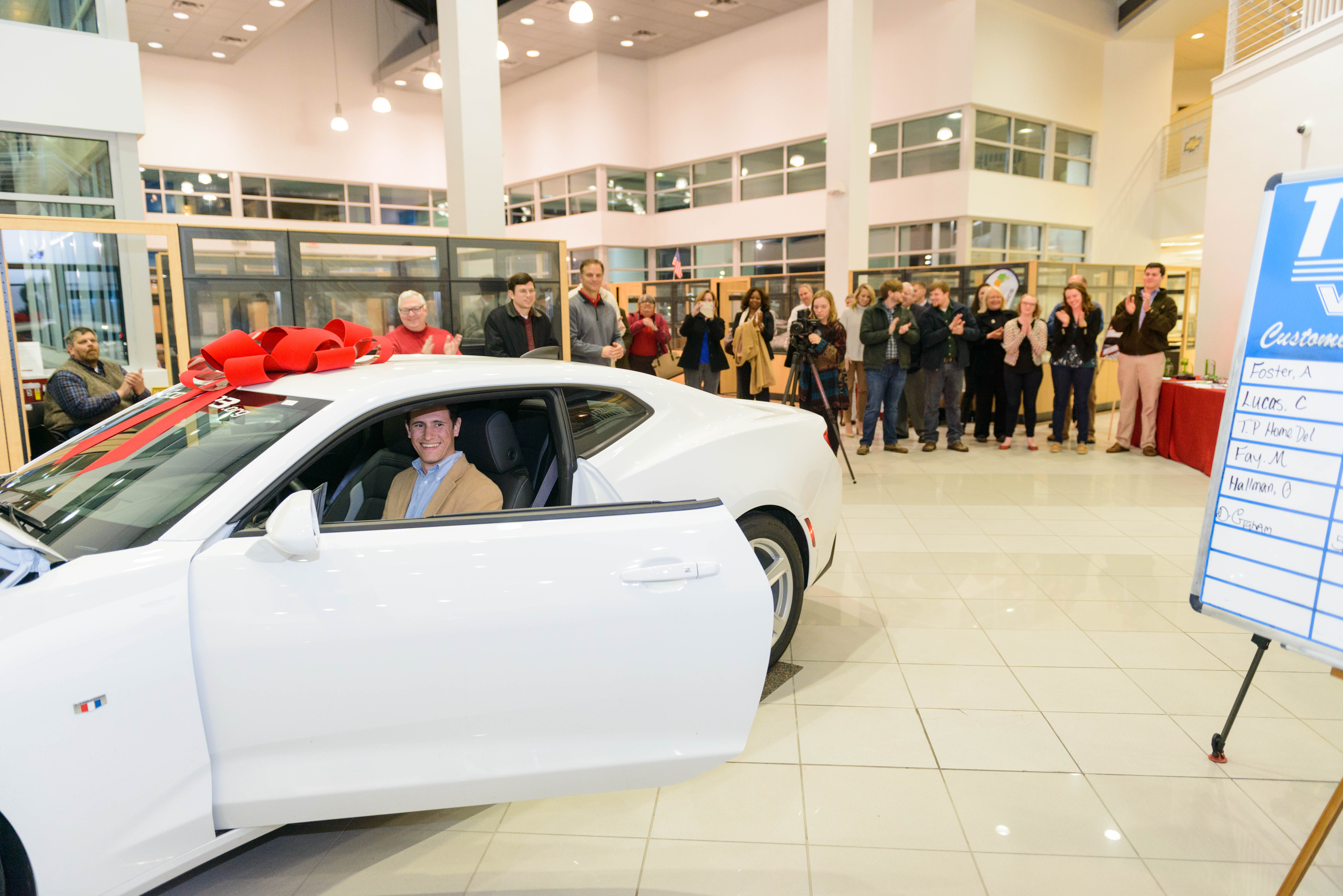Editor’s Note: The UA EcoCAR 3 team will unveil its 2016 Chevrolet Camaro at 5:30 p.m. Jan. 5 at Tuscaloosa Chevrolet. Media are invited to attend for interviews with team members and access to the car for photos or videos.

TUSCALOOSA, Ala. — After nearly 18 months preparing, The University of Alabama EcoCAR 3 team is ready to turn a 2016 Chevrolet Camaro into an advanced, significantly more energy-efficient vehicle that should maintain the speed and performance of the muscle car.
After the fall semester, the student team received a 2016 Chevrolet Camaro and has begun the process of implementing its sophisticated design and optimization work into the vehicle.
“Our team has been planning for over a year now, working together to establish a solid foundation for our specific vehicle development program as if this was an actual effort to bring our vision for the Camaro to market,” said Brittany Galloway, communications manager for UA’s team and a graduate student from Lansing, Michigan, studying advertising and public relations.
“Whether its communications, engineering or project management, everyone has been putting in tremendous effort to lead to our overall success,” she said. “The team is thrilled to finally be working with the actual vehicle and excited to start bringing the design work to life.”
In 2014, UA was selected as one of 16 institutions to participate in EcoCAR 3, an engineering competition sponsored by General Motors Co. and the U.S. Department of Energy that challenges students to create a car that uses less energy and emits less pollution without sacrificing performance, safety or consumer appeal.
This is the first team from UA in more than 20 years to participate in the Advanced Vehicle Technology Competition Series, established by federal energy department and managed by Argonne National Laboratory.
The four-year competition engages the next generation of automotive professionals in engineering, business and communications, allowing students to experience the vehicle development and launch process from design to marketing.
About 150 students from eight different disciplines are part of UA’s team. The team also works with the Capstone Agency, a student-run public relations firm, to help with social media and media relations.
During the competition, students conceive, design and integrate an innovative, state-of-the-art powertrain into the newly-redesigned Chevrolet Camaro, donated by GM, with the objectives of maximizing vehicle fuel efficiency, maintaining federal emissions and safety standards, and improving vehicle performance, all while satisfying consumer demands for flawless drivability and affordable cost.
The students’ success in meeting these objectives is evaluated yearly before the final evaluation at the end of the competition.
The UA team plans to turn the gasoline-powered Camaro into a blended plug-in hybrid with a smaller internal combustion engine supplemented by two electric motors.
The changes should mean the Camaro can travel 48 miles on the equivalent of one gallon of gasoline compared to the 28 mpg it is rated to achieve now, said Travis Foust, engineering project manager who graduated with a bachelor’s degree in mechanical engineering from UA in 2014 and is a graduate student in the same discipline.
Despite the improved energy efficiency, the car should still accelerate and drive with the same power as the commercially-available Camaro the team received from GM, he said.
“We aimed to maintain performance and improve fuel economy,” Foust said.
Under the team’s plan, the 3.6-liter, six-cylinder internal combustion engine that came with the Camaro will be replaced with a 2.4-liter, four-cylinder unit, but the two electric motors should make up for the smaller gas-powered engine with their capability of providing 32 and 106 additional kilowatts, respectively.
As a blended plug-in hybrid, the Camaro can optimally select among three power sources depending on the needs of the car. When the driver wants the full force of a muscle car, both electric motors will work in parallel with the engine to power the car.
It can also be driven entirely by electric power or run off one electric motor while the other works in series with the internal combustion engine to charge the battery.
When working in series, the gas engine and the electric motor charging the battery can be fully disengaged from driving the vehicle to most efficiently charge the battery, or the car can work in what’s called series/parallel mode where the speed of the engine depends on the vehicle’s speed while still working with one electric motor to charge the battery.
The efficiency-based control strategy will run the engine and electric motors in combination to supply driver-demanded torque with minimum fuel consumption. An algorithm programmed into a supervisory controller designed by the students will determine how the engines and motors work in concert to power the car and charge the battery, Foust said.
The only way the car would be powered solely by the internal combustion engine would be if both electric motors failed, Foust said. To fully charge the redesigned Camaro’s battery and enable maximum range, users would need to plug the hybrid vehicle into an electrical outlet for some time before departing on a trip; however the vehicle will always be able to be driven as long as there is some fuel in the gas tank.
A 12.6 kWh battery pack the students specified for the Camaro will eliminate some trunk space, but even with the added weight, the car should maintain the performance drivers expect from a Camaro, Foust said.
“If you’re going to downsize your engine in order to save fuel, you need to add a lot of electrical power,” he said. “To add that power, you need a battery pack that will supply the energy to that motor. It’s a huge challenge on a car this size, especially on a car that was never meant to have these components.”
Based on average gas and electricity prices in Alabama, the redesigned Camaro should cost about 5.7 cents per mile to drive compared to a cost of 8.6 cents a mile for the commercially-available Camaro.
The team plans to unveil the Camaro provided by GM at a reception at Tuscaloosa Chevrolet located 6500 Interstate 20 Cottondale, Alabama, 35453, Jan. 5 at 5:30 p.m. The students will work on the car this semester in space provided in the Electromechanical Systems Lab along with the Engines and Combustion Lab in the South Engineering Research Center on the UA campus.
The team’s advisers are Dr. Tim Haskew, head of the department of electrical and computer engineering; Dr. Rob Morgan, executive director for Innovation Initiatives in the Culverhouse College of Commerce; Mike Pope, instructor of marketing in the STEM Path to MBA program; Dr. Paul Puzinauskas, associate professor of mechanical engineering; and Dr. Hwan-Sik Yoon, assistant professor of mechanical engineering.
Contact
Adam Jones, UA media relations 205/348-6444, acjones12@eng.ua.edu
Source
Brittany Galloway, UA EcoCar3 Team communications manager, bjgalloway@crimson.ua.edu
